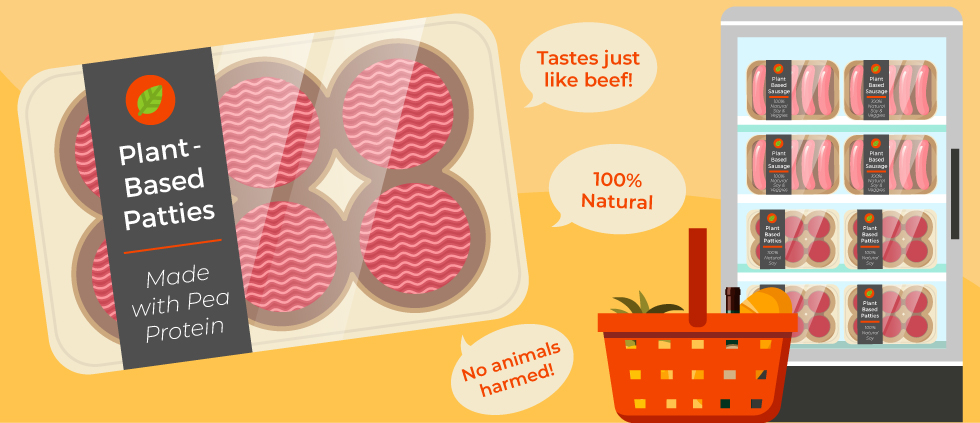How Alternative Protein Companies Can Navigate a Sea-Change in Consumer Demand During COVID-19

The COVID-19 pandemic is accelerating changes in virtually every industry category, including food and nutrition. The looming meat shortage portends to be an unanticipated boon for meat alternative protein companies, such as plant-based Beyond Meat whose shares recently surged 40% after rumblings of the expected effects of multiple meat plant closings during the first week of May. No doubt, other meat alternative ingredient companies are feeling the impact, too. Cricket flour anyone?
Clearly, this is an opportune time for meat alternative companies of all kinds – plant-based, grain-based, marine and insect alike. However, missteps could result in the demand surge becoming a bubble versus a permanent direction. Consumers will quickly return to meat as soon as inventory returns. The following are some tips for product development and marketing for manufacturers of alternative proteins:
Product development
- Meatless nutrition is not one size fits all and requirements are different for different regions. North Americans, for example, need more beans and lentils while Europeans need more nuts and seeds, according to an article from The Guardian.
- Remember that taste preferences vary across geographies and age groups. Millennials, for example, are far more adventurous than older demographics and are more eager to try exotic ingredients, naturally but brightly colored products, textures and unusual flavor combinations. We went into more detail on millennials in the food ingredient industry in a previous blog post.
- Think outside the box on new products for the “new normal.” Right now, during the pandemic, people are doing more in-home cooking, so catering to that may open opportunities for product types such as mix-in packets, stir-ins and sprinkles.
- Innovate protein formulations that deliver multiple benefits. The COVID-19 pandemic has stoked consumer interest in immunity ingredients and is expanding the need for products to address the epidemic of anxiety and stress. It makes sense to think about logical ingredient combinations, such as an immunity-building protein drinks or chocolate-flavored protein balls with ashwagandha to benefit physical and mood strength.
- Keep product formulation simple – the fewer the ingredients the better. Processed doesn’t automatically mean bad. If your product is processed, however, be transparent and clear about your ingredients on the label and product packaging.
- One thing that will never change is the idea that taste is king. If the product doesn’t taste good, the consumer will not repurchase.
Product messaging and marketing
- Match your messaging to your market.
- Baby boomers and older consumers may be more open to alternate protein sources because of the scarcity of meat, not because of interest in plant-derived food. Focus messaging on satisfaction or taste, e.g., “just like beef,” as long as you deliver on your promise.
- Millennials already lead the pack in orientation toward vegetarianism and flexitarianism, and while taste matters, messaging to this market would do well to focus on “doing good by eating well,” e.g., stats on saving the planet through reduced meat consumption, saving animals and creating a better world for future generations. If you can quantify the effects or contribute to a related cause based on purchase, this will work out in your favor. Millennials also respond well to messaging related to living healthy lifestyles.
- Use targeted marketing tactics.
- Authentic reviews and testimonials are a strong incentive for consumers to try new products.
- From a marketing perspective, social media is now at peak consumption. People are searching the internet, Instagram, Pinterest and YouTube for meal inspirations. There’s no time like the present to re-evaluate your media plan and consider amplifying your presence through paid and organic social content.
- Leverage digital marketplaces and promotions to target consumers looking for meatless protein options.
- Tap the appropriate influencers to impact your various product personas. Some yoga influencers, for example, have millions of followers who are interested in holistic well-being.
- Be sensitive to unique cultural factors. For example, one of the reasons why Chinese consumption of meat has been on the rise is because of the association of meat consumption with desirable Western affluence. If you are marketing your plant-based or alternate protein product to this market, consider presenting it in the context of being enjoyed by affluent Western consumers.
- The packaging of your product is also a message about your product’s authenticity. If you are marketing a protein alternative as a better choice for the world, the vehicle in which it is delivered to the consumer should represent likewise. So, “no” to polluting plastics, and “yes” to recycled or compostable materials.
There are always winners and losers in times of crisis. Though it’s difficult to think of being a winner during uncertain times, taking action to meet your consumers’ needs will make the best of world circumstances for your consumers, the planet and your business while also providing a strong foundation for the future.









